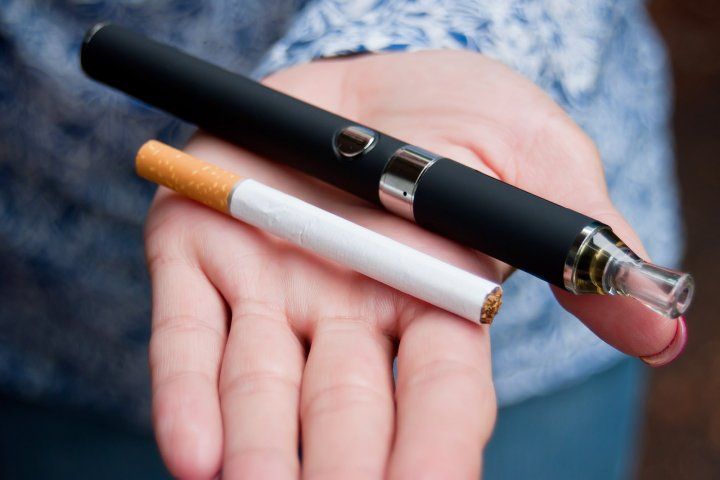E-Cigarettes, as Consumer Products, Do Not Help People Quit Smoking, Study Finds

E-cigarette use has risen steeply and mostly without regulation over the past decade. The devices have diversified into a dizzying array of vape pens, tank systems, “mods,” and more, mass-marketed and sold to the public. The U.S. Food and Drug Administration (FDA) is in the midst of considering whether to approve thousands of pre-market applications for the sale of e-cigarettes as consumer products.
In these applications and related advertisements, the owners of e-cigarette brands claim that their products help smokers quit and can therefore be considered “appropriate for the protection of public health,” as stipulated by law. But a new systematic review by UC San Francisco researchers of the scientific literature on this topic puts those claims to the test.
In the new study, published Dec. 22, 2020, in the American Journal of Public Health, a team led by UCSF’s Richard Wang, MD, MAS, surveyed the scientific community’s understanding of e-cigarettes and found that, in the form of mass-marketed consumer products, they do not lead smokers to quit.
In their paper, the authors write, “If e-cigarette consumer product use is not associated with more smoking cessation, there is no population-level health benefit for allowing them to be marketed to adults who smoke, regardless of the relative harm of e-cigarettes compared with conventional cigarettes. Moreover, to the extent that people who smoke simply add e-cigarettes to their cigarette smoking (becoming so-called dual users), their risk of heart disease, lung disease, and cancer could increase compared with smoking alone.”
“The question we explored is of both scientific interest and public health interest,” said Wang, assistant professor of medicine, “and we hope that the FDA will pay attention to our study as they try to make these decisions.” Wang was joined in the study by co–first author Sudhamayi Bhadriraju, MD, a former UCSF postdoctoral fellow who is now a pulmonologist at Kaiser Permanente in Redwood City, Calif., and senior author Stanton A. Glantz, PhD, professor of medicine.
The authors searched the literature, compiling results from 64 studies to answer this question. The studies selected for formal analysis encompassed observational studies, in which participants were surveyed, but not directed, about their use of e-cigarettes, as well as clinical trials in which smokers who were trying to quit were given free e-cigarettes under medical supervision.

Richard Wang, MD, MAS
This distinction mattered for their analysis, Wang noted. “In observational studies, you’re basically asking people ‘out in the wild’ about their use of e-cigarettes that they’ve purchased themselves from a corner store, without specific guidance to quit. But in a randomized trial you’re testing a product, treating it like a therapy – a medicine – to see if an e-cigarette or some other product is more conducive to quitting.”
In their analysis of observational studies that involved groups of people who already smoked and used e-cigarettes, whether or not they wanted to quit, the team found no appreciable effect of e-cigarettes on participants’ ability to quit. In the next group of studies, which surveyed smokers using e-cigarettes who did indicate a desire to quit, the researchers also found no effect.
Then the team tried to tease apart the effects of frequency of use – whether people who used e-cigarettes daily might quit at different rates than people who used them less often. The researchers found that daily users quit at a higher rate than more infrequent users, although they cautioned that most participants in U.S. studies fall into the second category.
Finally, they examined nine clinical trials, which provided some type of e-cigarette, for free, to participants who were specifically encouraged to use the devices to help them quit. Though the devices and the controls employed in the studies differed, Wang concluded that being provided with certain e-cigarette products in a clinical trial context led to more quitting than some other therapies.
The 2009 Family Smoking Prevention and Tobacco Control Act (TCA) charges the FDA with only allowing e-cigarettes on the market when manufacturers can prove their tobacco-based products are “appropriate for the protection of public health.” But the FDA delayed enforcing the law until a federal court order required companies to submit pre-market approval applications to the agency before September 2020 in order to continue selling e-cigarettes to consumers. The FDA is now evaluating thousands of such applications to sell e-cigarettes.
“It’s important to recognize that in clinical trials, when certain e-cigarette devices are treated more like medicine, there may actually be an effect on quitting smoking,” said Wang. “But that needs to be balanced against the risks of using these devices. Also, only seven e-cigarette devices were studied in the clinical trials. Whether the effect observed with these seven devices is the same or different than that of the thousands of different e-cigarette products available for sale is unknown.”
In addition, he said, the new study does not analyze the increase in youth and teen smoking as a result of e-cigarette marketing and availability, nor does it compare the negative health effects of e-cigarettes to traditional tobacco products.
With regard to the current decision before the FDA, Wang said, “The standards that the FDA has to apply to approve e-cigarettes as consumer products or therapeutic devices are fundamentally different.”
Funding: The work was supported by National Heart, Lung, and Blood Institute (F32HL144063, K12HL143961, T32HL007185, and cooperative agreement U54HL147127 from the National Heart, Lung, and Blood Institute and the Food and Drug Administration Center for Tobacco Products.
Disclosures: The authors report no conflicts of interest.
The University of California, San Francisco (UCSF) is exclusively focused on the health sciences and is dedicated to promoting health worldwide through advanced biomedical research, graduate-level education in the life sciences and health professions, and excellence in patient care. UCSF Health, which serves as UCSF’s primary academic medical center, includes top-ranked specialty hospitals and other clinical programs, and has affiliations throughout the Bay Area.